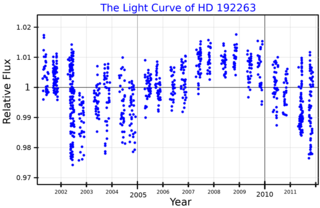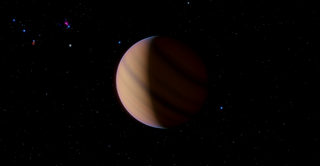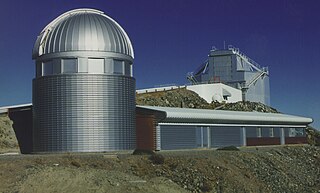Related Research Articles

HD 209458 is an 8th-magnitude star in the constellation Pegasus. It is a G0V star, and is thus very similar to the Sun. Because it is located at a distance of 157 light-years, it is not visible to the unaided eye. With good binoculars or a small telescope it should be easily detectable.
HD 169830 is a star in the southern constellation of Sagittarius. It has a yellow-white hue and is dimly visible to the naked eye with an apparent visual magnitude of +5.90. The star is located at a distance of 120 light years from the Sun based on parallax. It is drifting closer with a radial velocity of −17.3 km/s, and is predicted to come as close as 20.7 ly (6.4 pc) in 2.08 million years. HD 169830 is known to be orbited by two large Jupiter-like exoplanets.
HD 83443 is an orange dwarf star approximately 134 light-years away in the constellation of Vela. As of 2000, at least one extrasolar planet has been confirmed to be orbiting the star. The star HD 83443 is named Kalausi. The name was selected in the NameExoWorlds campaign by Kenya, during the 100th anniversary of the IAU. The word Kalausi means a very strong whirling column of wind in the Dholuo language.

HD 192263 is an 8th magnitude star about 64 light years away in the constellation of Aquila. The spectral type of the star is K2V, meaning that it is an orange dwarf, a type of star somewhat cooler and less luminous than the Sun. It is not visible to the unaided eye, but with good binoculars or small telescope it should be easy to spot.
HD 1237 is a binary star system approximately 57 light-years away in the constellation of Hydrus.

HD 28185 b is an extrasolar planet 128 light-years away from Earth in the constellation of Eridanus. The planet was discovered orbiting the Sun-like star HD 28185 in April 2001 as a part of the CORALIE survey for southern extrasolar planets, and its existence was independently confirmed by the Magellan Planet Search Survey in 2008. HD 28185 b orbits its sun in a circular orbit that is at the inner edge of its star's habitable zone.
109 Piscium is a yellow hued G-type main-sequence star located about 108 light-years away in the zodiac constellation of Pisces. It is near the lower limit of visibility to the naked eye with an apparent visual magnitude of 6.27. The star is moving closer to the Earth with a heliocentric radial velocity of −45.5 km/s. It has one known exoplanet.
HD 224693, also named Axólotl, is a star in the equatorial constellation of Cetus, and is positioned near the western constellation border with Aquarius. It can be viewed with a small telescope but is too faint to be seen with the naked eye, having an apparent visual magnitude of 8.23. Based on parallax measurements, the object is located at a distance of approximately 306 light years from the Sun. It is drifting further away with a radial velocity of 1.5 km/s.

Pollux b, also designated β Geminorum b and HD 62509 b, formally named Thestias, is an extrasolar planet approximately 34 light-years away in the constellation of Gemini. This planet was discovered orbiting the star Pollux in 2006 by astronomer Artie P. Hatzes, confirming his hypothesis originally published in 1993. The planet has at least twice the mass of Jupiter. It moves around Pollux in 1.61 years at a distance of 1.64 AU in a nearly circular orbit.
HD 154345 is a star in the northern constellation of Hercules. With an apparent visual magnitude of +6.76 it is a challenge to view with the naked eye, but using binoculars it is an easy target. The distance to this star is 59.6 light years based on parallax, but it is drifting closer with a radial velocity of −47 km/s. At least one exoplanet is orbiting this star.

109 Piscium b is a long-period extrasolar planet discovered in orbit around 109 Piscium. It is about 5.74 times the mass of Jupiter and is likely to be a gas giant. As is common for long-period planets discovered around other stars, it has an orbital eccentricity greater than that of Jupiter.
HD 24040 is a metal-rich G-type star located approximately 152 light-years away in the constellation of Taurus. In 2006 a long-period planet was discovered.
HD 52265 b, formally named Cayahuanca, is a gas giant exoplanet located approximately 98 light-years away in the constellation of Monoceros, orbiting the star HD 52265. The planet has a minimum mass slightly more than that of Jupiter. Mean distance between the planet and the star is half that of Earth from the Sun. It was discovered by both the California and Carnegie Planet Search team and the Geneva Extrasolar Planet Search team independently of each other. By studying the fluctuations of the brightness of a host star, the inclination of the stars equator was determined. This allowed to calculate its true mass, assuming that the planet orbits in the plane of the star's equator.
HD 222582 b is an extrasolar planet that is 8.37 times the mass of Jupiter orbiting the star HD 222582. The orbital period is 572 days and orbits at a semimajor axis of 1.35 AU in one of the most eccentric orbits of the known planets.
HD 117207 b is an exoplanet orbiting at 3.77 astronomical units around HD 117207, taking about 7.14 years to complete its orbit. Its orbit has a low to moderate eccentricity. This planet was announced in January 2005 by Marcy at the Keck Observatory. HD 117207 b has a minimum mass of 1.88 Jupiter masses, and in 2023 its inclination and true mass were determined via astrometry.
HD 75289 b is an extrasolar planet orbiting the star HD 75289 in Vela constellation. It has a minimum mass half that of Jupiter, and it orbits in a very short orbit completing one circular revolution around the star in three and a half days. By studying the starlight scientists have concluded that the planet must have an albedo less than 0.12, rather low for a gas giant. Otherwise its reflected light would have been detected.
HD 40979 b is an extrasolar planet orbiting the star HD 40979, was detected from the Lick and Keck observatories and photometric observations at Fairborn Observatory reveal low-amplitude brightness variations in HD 40979. It is thought to be a large gas giant planet. It was discovered in 2002 by Debra Fischer.
HD 40307 b is an extrasolar planet orbiting the star HD 40307, located 42 light-years away in the direction of the southern constellation Pictor. The planet was discovered by the radial velocity method, using the European Southern Observatory's HARPS apparatus, in June 2008. It is the second smallest of the planets orbiting the star, after HD 40307 e. The planet is of interest as this star has relatively low metallicity, supporting a hypothesis that different metallicities in protostars determine what kind of planets they will form.
HD 40307 d is an extrasolar planet orbiting the star HD 40307, located 42 light-years from Earth in the direction of the southern constellation Pictor. The planet was discovered by the radial velocity method, using the HARPS apparatus in June 2008. It is the most massive of the six proposed planets in the system. The planet is of interest as this star has relatively low metallicity, supporting a hypothesis that different metallicities in protostars determine what kind of planets they will form.

Leonhard Euler Telescope, or the Swiss EULER Telescope, is a national, fully automatic 1.2-metre (47 in) reflecting telescope, built and operated by the Geneva Observatory. It is located at an altitude of 2,375 m (7,792 ft) at ESO's La Silla Observatory site in the Chilean Norte Chico region, about 460 kilometers north of Santiago de Chile. The telescope, which saw its first light on 12 April 1998, is named after Swiss mathematician Leonhard Paul Euler.
References
- Notes
- 1 2 Santos, N. C.; et al. (2000). "The CORALIE survey for Southern extra-solar planets III. A giant planet in orbit around HD 192263". Astronomy and Astrophysics. 356: 599–602. Bibcode:2000A&A...356..599S. Archived from the original on 2011-09-28. Retrieved 2008-11-04.
- ↑ "Astronomers discover six new planets orbiting nearby stars" (Press release). Kamuela, Hawaii: W. M. Keck Observatory. November 1, 1999. Retrieved December 19, 2017.
- ↑ Vogt, Steven S.; et al. (2000). "Six New Planets from the Keck Precision Velocity Survey". The Astrophysical Journal. 536 (2): 902–914. arXiv: astro-ph/9911506 . Bibcode:2000ApJ...536..902V. doi:10.1086/308981. S2CID 119375519.
- ↑ "Approved names". NameExoworlds. Retrieved 2020-01-02.
- ↑ "International Astronomical Union | IAU". www.iau.org. Retrieved 2020-01-02.
- ↑ See, "No Planet at All: Star Fools Astronomers, Who See Spots". Space.com article. Archived from the original on 2002-10-04.
- ↑ Santos, N. C.; et al. (2003). "The CORALIE survey for southern extra-solar planets XI. The return of the giant planet orbiting HD 192263". Astronomy and Astrophysics. 406 (1): 373–381. arXiv: astro-ph/0305434 . Bibcode:2003A&A...406..373S. doi:10.1051/0004-6361:20030776. S2CID 16247618.
- ↑ Han; Black, David C.; Gatewood, George (2001). "Preliminary Astrometric Masses for Proposed Extrasolar Planetary Companions". The Astrophysical Journal Letters. 548 (1): L57–L60. Bibcode:2001ApJ...548L..57H. doi: 10.1086/318927 .
- Bibliography
- Henry; Donahue, Robert A.; Baliunas, Sallie L. (2002). "A False Planet around HD 192263". The Astrophysical Journal Letters. 577 (2): L111–L114. Bibcode:2002ApJ...577L.111H. doi: 10.1086/344291 .